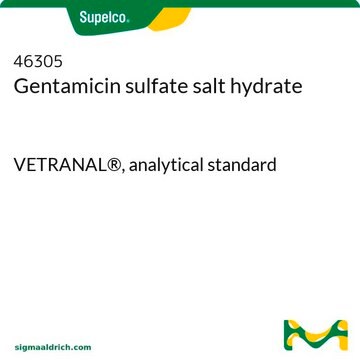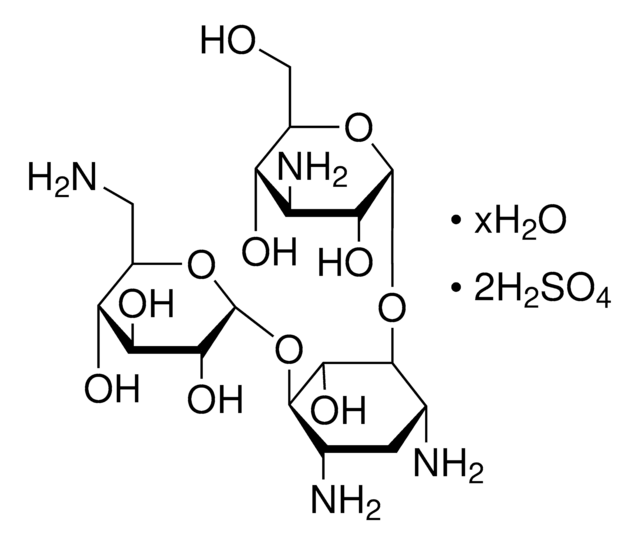A2024
Apramycin sulfate salt
Synonyme(s) :
Nebramycin II
About This Item
Produits recommandés
Source biologique
Streptomyces tenebrarius
Niveau de qualité
Forme
powder
Couleur
white to brown
Spectre d'activité de l'antibiotique
Gram-negative bacteria
Mode d’action
protein synthesis | interferes
Température de stockage
2-8°C
Chaîne SMILES
OS(O)(=O)=O.CN[C@H]1[C@@H](O)[C@H]2O[C@H](O[C@@H]3[C@@H](N)C[C@@H](N)[C@H](O)[C@H]3O)[C@H](N)C[C@@H]2O[C@@H]1O[C@H]4O[C@H](CO)[C@@H](N)[C@H](O)[C@H]4O
InChI
1S/C21H41N5O11.H2O4S/c1-26-11-14(30)18-8(33-20(11)37-21-16(32)13(29)10(25)9(4-27)34-21)3-7(24)19(36-18)35-17-6(23)2-5(22)12(28)15(17)31;1-5(2,3)4/h5-21,26-32H,2-4,22-25H2,1H3;(H2,1,2,3,4)/t5-,6+,7-,8+,9-,10-,11+,12+,13+,14-,15-,16-,17-,18+,19+,20-,21-;/m1./s1
Clé InChI
WGLYHYWDYPSNPF-RQFIXDHTSA-N
Vous recherchez des produits similaires ? Visite Guide de comparaison des produits
Catégories apparentées
Description générale
Application
Actions biochimiques/physiologiques
Conditionnement
Autres remarques
Mention d'avertissement
Danger
Mentions de danger
Conseils de prudence
Classification des risques
Repr. 1B
Code de la classe de stockage
6.1C - Combustible acute toxic Cat.3 / toxic compounds or compounds which causing chronic effects
Classe de danger pour l'eau (WGK)
WGK 3
Point d'éclair (°F)
Not applicable
Point d'éclair (°C)
Not applicable
Équipement de protection individuelle
Eyeshields, Faceshields, Gloves, type P2 (EN 143) respirator cartridges, type P3 (EN 143) respirator cartridges
Certificats d'analyse (COA)
Recherchez un Certificats d'analyse (COA) en saisissant le numéro de lot du produit. Les numéros de lot figurent sur l'étiquette du produit après les mots "Lot" ou "Batch".
Déjà en possession de ce produit ?
Retrouvez la documentation relative aux produits que vous avez récemment achetés dans la Bibliothèque de documents.
Les clients ont également consulté
Notre équipe de scientifiques dispose d'une expérience dans tous les secteurs de la recherche, notamment en sciences de la vie, science des matériaux, synthèse chimique, chromatographie, analyse et dans de nombreux autres domaines..
Contacter notre Service technique













